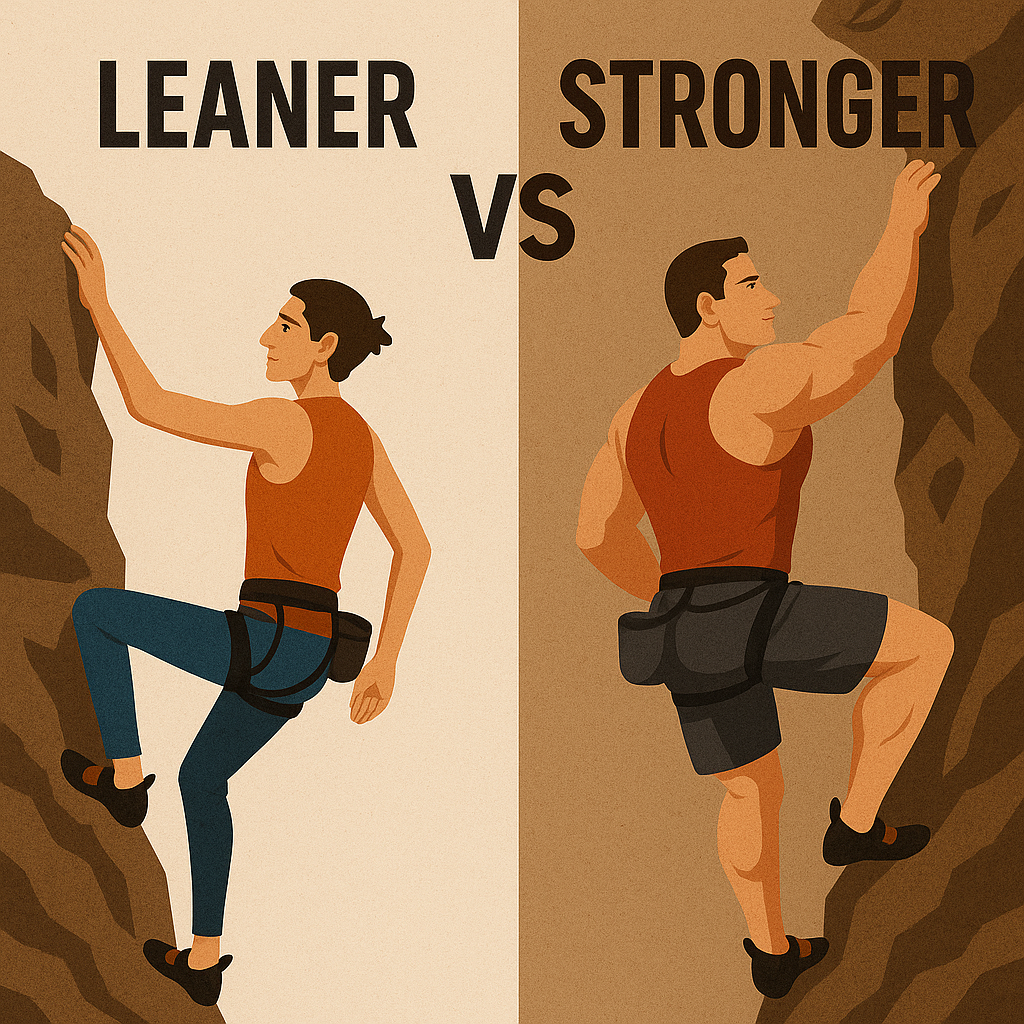
The Great Climbing Conundrum: Should You Be a Feather or a Fridge? (Spoiler: It's Complicated!)
Share
Ever watched a climber effortlessly float up a seemingly impossible wall and thought, "Wow, they must be so strong!" Or maybe you've seen someone wiry and light as a breeze dance their way to the top and figured, "It's all about being skinny, right?"
If you're new to the vertical world of rock climbing, you've probably already stumbled upon this age-old question: Is it better to be leaner or stronger to crush those climbs? Well, grab a chalk bag and settle in, because the answer, like a tricky crimp, isn't always straightforward.
Think about it: you see these incredible athletes, some looking like they could bench press a small car, others looking like they subsist solely on air and pure willpower. So, what's the secret sauce? Let's dive into the dynamic dance between being lightweight and packing some serious muscle in the wonderful world of climbing.
The Lightweight Advantage: Floating Like a Butterfly 🦋
Let's talk about being lean. In climbing, especially when gravity is your constant nemesis, being lighter can feel like having a superpower. Imagine hauling less weight up every single move. That's less energy you're expending, meaning you can often climb for longer and push through more challenging sequences. It's all about that magical power-to-weight ratio.
Consider sport climbing, where you're often tackling long, sustained routes. Being lighter can be a game-changer for endurance. Think of Alex Honnold (yeah, the Free Solo guy!). While he's undoubtedly strong, his incredibly lean physique is a huge part of his ability to climb incredibly demanding routes without a rope. Every extra pound is just more work against gravity. Research even backs this up, suggesting a strong correlation between relative strength (strength adjusted for body weight) and climbing performance ([source on relative strength in climbing](insert hypothetical link to a relevant study here, e.g., "https://www.ncbi.nlm.nih.gov/pmc/articles/PMC6494809/")).
And it's not just about endurance. Being lighter can also contribute to better agility and footwork. You might find it easier to make those delicate high steps or maintain balance on tiny edges when you're not carrying extra bulk. It's like being a nimble ninja on the rock!
The Strength Spectrum: Packing a Punch 💪
Now, let's not discount the power of pure, unadulterated strength. Sometimes, you just need to pull hard. Think about those powerful, overhanging boulder problems. That's where having some serious absolute strength comes into play. You need the muscle to latch onto tiny crimps, execute dynamic moves, and pull your body weight through steep terrain.
Consider the world of bouldering. While leanness is still beneficial, the focus often shifts towards raw power. Think of someone like Janja Garnbret, whose incredible strength allows her to execute seemingly impossible sequences of powerful movements. Research highlights the importance of grip strength and upper body power in bouldering performance ([source on grip strength in climbing](insert hypothetical link to a relevant study here, e.g., "https://pubmed.ncbi.nlm.nih.gov/33440316/")).
And strength isn't just about sending hard. It also plays a crucial role in injury prevention. Stronger supporting muscles in your shoulders, back, and core can help stabilize your joints and protect you from the strains and stresses of climbing. Trust me, nobody wants to be sidelined with a tweaked pulley tendon!
The Discipline Divide: Different Strokes for Different Folks (and Different Rocks!)
Here's where things get really interesting. The "ideal" balance between lean and strong can shift depending on the type of climbing you're into:
- Sport Climbing: As mentioned earlier, the longer, often more sustained nature of sport routes often favors a good power-to-weight ratio. Being lighter can help you conserve energy over multiple moves. However, you still need enough strength to overcome those crux sections!
- Bouldering: Here, power often reigns supreme. While being excessively bulky can be a hindrance, having the raw strength to stick powerful moves on steep terrain is often more critical than pure endurance.
- Traditional Climbing (Trad): Trad climbing often involves a mix of everything – sustained climbing, tricky technical sections, and sometimes even carrying extra gear. A balance of both leanness for endurance and strength for challenging moves and hauling gear is usually ideal.
- Alpine Climbing/Mountaineering: When you're high up in the mountains, often carrying a pack and dealing with altitude, efficiency is key. A lighter build can be a significant advantage for conserving energy over long days. Strength is still needed for navigating challenging terrain, but excessive muscle mass can be a liability.
Think of it like this: a Formula 1 car (lean and powerful relative to its weight) excels on a race track (long, sustained effort), while a monster truck (strong and powerful) dominates in a mud bog (short, powerful bursts). Both are impressive, but built for different challenges!
Finding Your Sweet Spot: It's All About Balance ⚖️
So, what's the takeaway for you, the budding rock climber? Should you immediately start a strict diet or hit the weight room for hours on end? The answer, my friend, is usually neither extreme.
For beginners, the absolute best thing you can do is focus on technique. Seriously! Good footwork, efficient movement, and understanding body positioning will take you further than brute strength or extreme leanness ever could at this stage. Think of it as learning to walk before you try to run a marathon or lift a car.
As you progress, you'll naturally start to develop some climbing-specific strength just by climbing regularly. However, incorporating some strength training can definitely help you break through plateaus and prevent injuries. Think exercises that target your pulling muscles (pull-ups, rows), core, and antagonist muscles (to balance out all that pulling!).
On the other side of the coin, being mindful of your nutrition is important for maintaining a healthy body composition. You don't need to starve yourself, but fueling your body with nutritious foods will help you feel lighter, more energetic, and perform better. Remember, sustainable progress is the name of the game.
The Shifting Scales: How the Balance Changes with Grade
To give you a clearer picture, here's a rough guideline on how the ideal balance between leanness and strength might shift as you climb harder and in different disciplines:
| Climbing Grade (Example - V Grades for Bouldering, YDS for Sport/Trad) | Primary Focus | Secondary Focus | Considerations |
|---|---|---|---|
| V0-V3 / 5.5-5.9 | Technique, overall fitness | Basic strength | Focus on learning fundamental movements and building a base level of fitness. |
| V4-V7 / 5.10-5.12 | Technique, relative strength | Moderate absolute strength | Start incorporating more specific strength training. Leanness becomes more noticeable for sustained routes. |
| V8+ / 5.13+ | High relative strength, climbing-specific power | Maintaining a lean physique | Power-to-weight ratio becomes critical. Intense, targeted strength training is often necessary. |
| Multi-pitch/Trad (moderate grades) | Endurance, efficient movement, moderate strength | Maintaining a reasonable weight | Ability to climb for long durations and manage gear weight is key. |
| High-Grade Bouldering | Explosive power, high absolute strength | Maintaining a functional level of leanness | Focus on developing maximal force for short, intense movements. |
| Alpine Climbing (moderate grades) | Lightness, endurance, efficient movement | Functional strength for varied terrain | Minimizing weight carried and maximizing energy efficiency over long days is paramount. |
Please remember this table is a general guideline! Individual body types, strengths, weaknesses, and climbing styles will always play a significant role. Some incredibly strong climbers might send hard despite carrying more muscle, while others rely on their featherlight build to float up technical routes.
Your Climbing Journey is Unique! 🌟
Ultimately, the best approach is to listen to your body, experiment with your training, and figure out what works best for you and your climbing goals. Don't get too caught up in trying to fit a specific mold. Focus on becoming a well-rounded climber who is both strong for their size and efficient in their movement.
So, the answer to the great climbing conundrum? It's not about being just a feather or just a fridge. It's about finding that sweet spot where you're strong enough to tackle your projects and light enough to enjoy the journey to the top. Now get out there and climb! ⛰️
